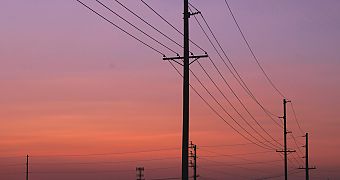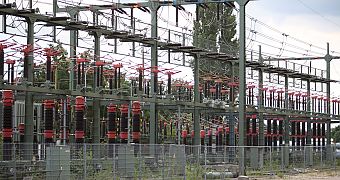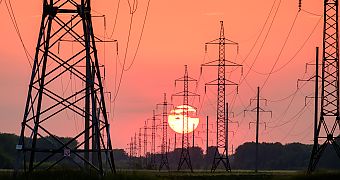Software for a predictive grid management
Sophisticated IT platform for grid operators
What is our grid platform actually used for? The video shows how our modular platform creates a digital twin of the power grid for grid operators, enabling efficient, secure, and predictive grid management.
With the growing number of volatile renewable energy producers, the management of the electricity grid gets more and more complex. To exploit the full potential of renewable energies, we developed FuturePowerFlow – a globally unique algorithm-driven system. It laps locations of the many thousands decentralized renewable energy generators, weather forecasts, operation modes of renewable energy plants, grid infrastructure data and demand forecasts to make the integration of renewables precisely plannable for the next 48h. Instead of just reacting on circumstances, we enable grid operators to recognise grid congestions at an early stage, actively plan and exactly control the mix of energies in their grids avoiding unnecessary congestions and reducing their costs.
FuturePowerFlow operates in accordance with the various implementation specifications of different country's such as the European Renewable Energy Directive or the German Grid Expansion Acceleration Act (NABEG 2.0)
FuturePowerFlow is characterized by its modular software architecture in a "Platform as a Service" (PaaS) approach. On the one hand, the platform can cover the complete process of forecasting, grid flow calculation, scheduling and accounting. On the other hand, it also allows the flexible combination of individual functionality and individual configuration for each user. Our software integrates smoothly into existing processes and IT architectures. Thus, the platform adapts to the different requirements of different users, from distribution system operators at different voltage levels to transmission system operators at the highest voltage level. The flexibility of this complete solution is also demonstrated by the numerous grid operators who already rely on FuturePowerFlow for the implementation of Redispatch 2.0.
On May 13, 2019, the German legislator passed the Grid Expansion Acceleration Act (NABEG), which contains essential specifications for the new methods of grid congestion management "Redispatch 2.0". These specifications have to be implemented by grid operators by October 1, 2021. Redispatch 2.0 replaces the existing specifications for feed-in management and for the first time integrates renewable energies and distributed producers from 100 kW into the Redispatch process.
The Redispatch process no longer reacts in real time to grid congestions but rather creates grid analyses based on forecasts and identifies bottlenecks at an early stage. Thus, measures against expected grid bottlenecks of operating resources can be initiated proactively.
The redispatch 2.0 process essentially comprises the following steps:
- A high resolute grid network analysis and forecast based on individual plant forecast, schedules, grid states and consumption.
- The prediction of load flows and congestion in different variations.
- An optimized redispatch dimensioning and the subsequent implementation of a plant scheduling.
- The market communication between different players as well as balancing and accounting.
Cost-efficient prevention of grid congestion
The cost-efficient prevention of grid congestion is a core function of FuturePowerFlow. The results of the network analysis of the customer's grid are used to calculate the necessary measures on the individual plant level. In addition, FuturePowerFlow takes into account the requirements received from upstream or downstream grid operators via the standardized communication interfaces.
The platform uses the flexibility potential of the individual plants to eliminate congestion and keeps the number of affected plants to a minimum. Taking into account the available plants, the optimizer developed by emsys grid services calculates the necessary measures for the efficient elimination of a bottleneck within a few seconds.
Plant Scheduling
FuturePowerFlow is characterized by numerous communication interfaces to upstream and downstream grid operators as well as directly to responsible plant operators. This enables the platform to quickly initiate the scheduling of flexibility requests or even to carry them out itself. With regard to the control of individual assets, our partner company emsys VPP has an extensive experience in the real-time control of thousands of plants through its Virtual Power Plants.
Standardized market communication
For the implementation of future grid management processes between different grid operators (distribution grid operator and transmission grid operator) as well as between grid operators and significant grid users is of fundamental importance. FuturePowerFlow, therefore, includes all relevant interfaces and communication options for the execution of data exchange, balancing and billing processes.
The basis for the standardized market communication in the platform are the network codes established the European Union, including the Systems Operations Guideline (SOGL) and the Generation and Load Data Provision Methodology (GLDPM). The Common Grid Model Exchange Standard (CGMES) is used for the exchange of grid model data. Power plant deployment plans, planning data and unavailabilities can be received directly from the responsible parties for deployment and are taken into account together with other forecasts, switching states etc. Beyond the European requirements, the national requirements for data exchange are also implemented like the German PVK/PVZ/NKK.
Balancing & Accounting
FuturePowerFlow also supports grid operators in the billing process of congestion measures in accordance with different guidelines like the German "BDEW Guidelines for the Calculation of Failure Work Redispatch 2.0". A model based on the planned and realized power can be used as a basis for the calculation as well a forecast method, which uses external data (power curves, wind speed data) to estimate the possible production.
At the end of the determination of possible production a tolerance check is performed. Within the scope of the invoice generation, the system checks in which market price situation the work-output was incurred or calculates the market price of the work-output. The calculation is based on the EPEX spot exchange electricity prices and other stored price time series (e.g. Intraday ID1).
FuturePowerFlow integrates manual bill reading, payment, reporting and comprehensive monitoring. And if billing specifications change in the future, FuturePowerFlow enables uncomplicated adjustment.
You want to learn more about our solution for grid management?
Please contact us for further information:
Tel. +49 441 212 110 or mail@emsysgrid.de

The project leading to this application has received funding from the European Union's Horizon 2020 research and innovation programme (grant agreement No 947129).




